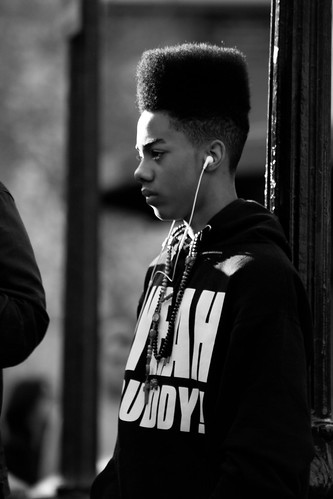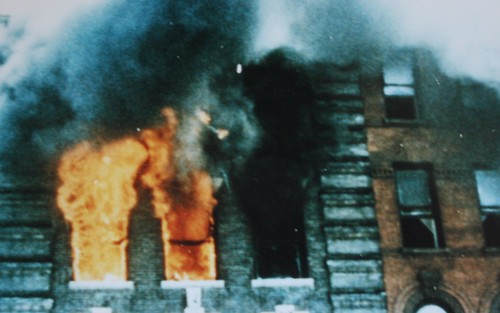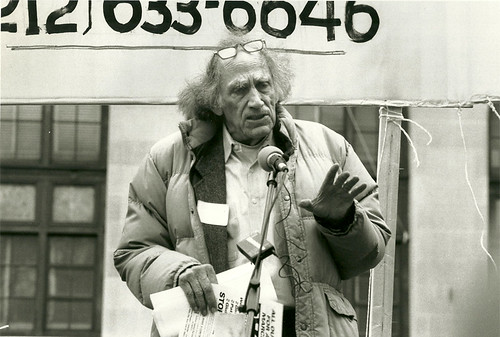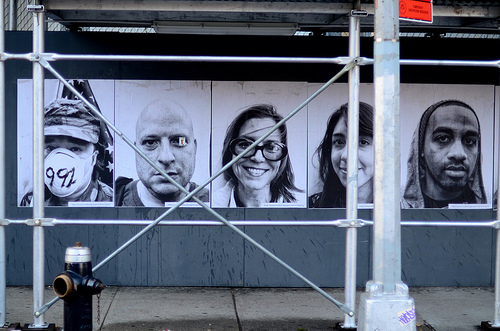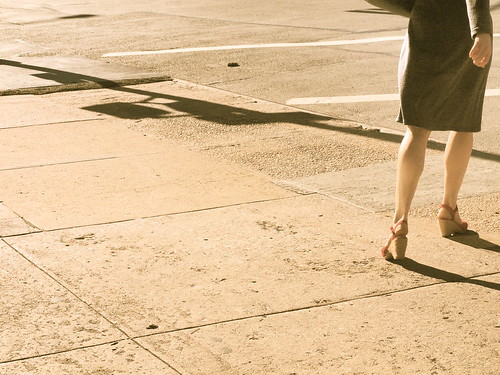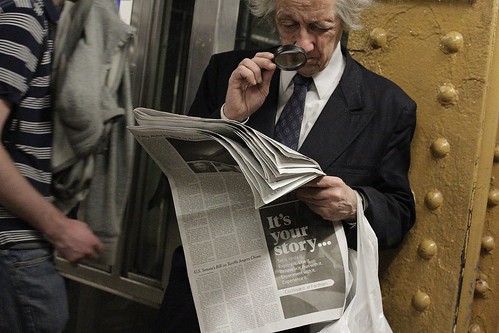Today, we tip our hat to a couple of locals who are making the East Village a greener, cleaner place.
Photos from “East River and the Sanctum we walk” by Alan Gastelum.
 Alan Gastelum Garbage collection this past weekend.
Alan Gastelum Garbage collection this past weekend.Some people go to the park to photograph birds, while others document trees. Alan Gastelum photographs garbage. This past weekend, he and 20 volunteers filled almost two dozen industrial-sized bags with trash gathered on the banks of the East River.
The cleanup effort at the East River Promenade was organized by the photographer along with Partnerships for Parks and the Lower East Side Ecology Center.
Almost two years ago, Mr. Gastelum, 31, an East Village resident who enjoyed relaxing in the park, began taking pictures of stray items that washed ashore: broken marine rope, dirty T-shirts, bottle caps, baseballs and toys. With every new tide, different items would wash onto the rocks, he said. Some of them, he kept: he has collected ceramic coffee mugs, wooden planks, single sneakers and plastic relics beaten smooth by the East River. Read more…
With the Republican National Convention underway in Tampa, Fla., photographer Matthew Kraus shares some thoughts and images of a convention that hit closer to home.
The few years following 9/11 were an interesting time in New York City. There seemed to be a closeness among New Yorkers that only such an event could foster. And there was certainly more than a little dissatisfaction in what our government was doing, partially in the name of that day. So when the Republican Party chose New York as the location of its convention during its 2004 bid to reelect Bush, there was a sizable amount of protest in all the usual places (the U.N., City Hall, Wall Street, etc.). Meanwhile in and around the East Village, I started noticing more and more signs, posters and predominantly stickers.
In those days, I would walk my then three-year-old to school from 14th Street and Avenue C to Second Street and Avenue A, and if I took a different route every day, I could photograph no less than 20 unique versions of these “protests.” They went up with shocking volume and speed and ranged from direct confrontation with Bush, to specific 9/11 references; from general rejection of the Republican Party to actual calls for action. Read more…
I have lived in and photographed the East Village since 1983. There really are eight million stories in the Naked City and you will find whatever one you want out there. Over eight million people live here, and I am going to photograph one or two of them at a time, alone with a situation. I want the viewer to feel the intimacy of this one person by that one building, to know there is a history here, to feel the narrative, without even knowing the story. And sometimes the building will tell me the story of the person who isn’t in the photo anymore.
This man is in front of a closed up space on East Sixth Street that used to be the Gladiators Gym. I was a member there in 1985. One of only two women that belonged. Kind of a hardcore lifting joint. Sad to see it closed up. I love the flat black paint, like a blackboard.
Read more…
Brian Rose’s new book, “Time and Space on the Lower East Side,” juxtaposes street scenes from 1980 with images from 2010. The Local asked him to share some of his favorites from the book – as well as some more recent photos – along with his thoughts about the world of change he has documented.
 East 4th Street – 1980
East 4th Street – 1980In 1980, shortly after graduating from Cooper Union I began photographing the Lower East Side, which includes the East Village, in collaboration with Ed Fausty. Walking in the footsteps of photographers Jacob Riis and Berenice Abbot, and inspired by new developments in color photography, we documented the neighborhood over the course of a year with a 4×5 view camera. It was, perhaps, the neighborhood’s darkest, but most creative moment. While buildings crumbled and burned, artists and musicians came to explore and express the edgy quality of the place.
After moving on to other projects and living in Amsterdam for 12 years, I decided to return to where I first made my stand in New York – the Lower East Side, where so many Americans trace their roots: the old neighborhood tucked beneath the bridges, lying at the feet of the pinnacles of power, would serve as a barometer of change and continuity. Read more…
Union Square has a knack for drawing the talented, the bored, and the show-offs to its broad open spaces. For that reason I gravitate to this part of the city on a daily basis in order to capture some of its magic and to add some of my own. Now Occupy Wall Street protesters have bitten off quite a chunk of the south side of Union Square, and in response, police officers hover around the perimeter of the park, poised to stop anything unruly or obstructive. Despite surveillance, artists, street performers and park-goers don’t seem to shy away from self expression. Rush hour is a great time to take photos not only because the park is flooded with characters, but also because it’s then that the sun is likely to create interesting highlights and shadows on faces.
Read more…
Ralph Feldman, 76, was a fireman in the Bronx with Engine 45 for two decades, and then in Harlem with Engine 37 for several years. Before retiring about 26 years ago, he served as a fire marshal intermittently. In 1969, he bought a building at 315 East Eighth Street and in the 1970s and ’80s he photographed fires near there, sometimes giving a hand to his fellow firefighters.
On his block of mostly vacant buildings, there were as many as five fires a week, said Mr. Feldman. “At the same time when the Bronx was burning, the East Village was burning,” he said. “All of Brooklyn was burning. In the ’70s and ’80s, big portions of the city burnt down.” Mr. Feldman spoke with The Local about his photos.
Read more…
“I find the East Village to be a difficult place to take photos. Difficult because our visual world is saturated with images of these blocks. Thus, you can feel trapped in a cliché — a cliché based in an idealized past, or a gentrified, dystopian vision of what is to come. Nevertheless, I love to photograph the East Village to participate in this negotiation. The negotiation is, for me, encapsulated in this idea of ‘Everyday Abstractions.'”
Read more…
Eater has a write-up of one of The Local’s favorite watering holes, Lucy’s. The article examines the revered bartender who has gotten plenty of attention on this site, but it’s the photographs that caught our attention; has Lucy’s ever been so…bright? It appears likely that the photographer brought in lights for his shots, giving the dive a whole new look. Regardless, it’s a timely primer for happy hour, which is just around the corner.
I was born in the East Village in the 1940s and lived here for most of my life. I was active in the East Village cultural scene, and tried my hand at acting and stand-up comedy for a time. When I started using photography as a medium of expression, it became second nature for me to document local history through my lens. Today, I host a public access TV show on Manhattan Neighborhood Network (M.N.N.) called “Harvey’s Earth and Beyond,” and many of my ideas for my show come from my performance days in the East Village.
I shot this photo of William Kunstler rallying at Cooper Union. He was one of the most celebrated civil rights attorneys, having headed up the A.C.L.U., defending the Chicago Seven, the Black Panthers, etc. He was a master at public relations, especially with the press. I believe this was one of his last appearances before he passed away.
Read more…
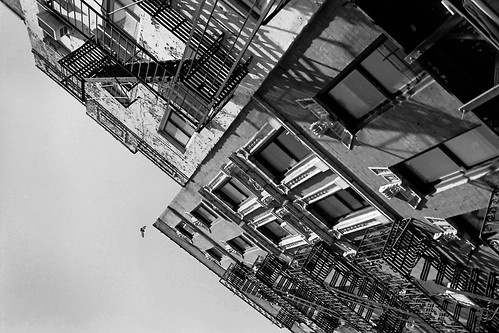 1st Avenue near 12th Street
1st Avenue near 12th StreetThese photographs are excerpted from a series called “The Paradox of Identity.” It is a work in progress and it has been for a while (since 1985). It is first referred to in my journal as “The Pigeon Project” and later on became “If You Can Name It…”
I am naturally suspicious of grand names for things, so I need to explain: We don’t have a big sky in New York City, so the intersection of sky and city is a big part of looking up around here. I have for some reason been drawn again and again to the sight of a patch of sky etched out by the buildings enclosing it, and the fleeting glimpse of a pigeon entering or leaving. I always feel a brief pang of want when I see it: “If I could only fly like a bird; if I could only be free…of myself.” Read more…
If you just can’t get enough of the images coming out of Occupy Wall Street, you’re in luck: JujoMukti will be hosting a photo exhibit of the protests on Dec. 1. The Local’s photographers and videographers have filed numerous dispatches from Lower Manhattan and Union Square; one of our contributors even spent two nights behind bars. Doors open at 7 p.m. at the tea lounge on East Fourth Street between Avenues A and B. Just be careful where you park your bicycle.
If you’re feeling welcoming — and aren’t camera-shy — Bowery Boogie has information regarding a photography student who is hoping to photograph local residents inside their homes. The student at the International Center for Photography was charged with documenting the neighborhood in a unique way, and decided that portraits would be a welcome departure from familiar shots of the Bowery or Tompkins Square Park. “I was hoping to get a range of people to capture the diversity of the LES,” he wrote.
For “1,150 Days,” I’ve photographed elements of day-to-day life in New York City to create a daily record of the environment I call home. It’s interesting how many different versions of New York have surfaced: a city centered around parked bicycles, a city of colorful lights and abstract shapes, and a city where pigeons try to fit in, too. Each of these seemingly mundane perspectives reveals a sense of levity and wonder; a reminder that the background of our daily lives is comprised of many unexpected and often missed details. What draws me to shoot in the East Village is the area’s culture, its fascinating people, and the living history of each block. Like JR’s TED-prize-winning Inside Out Project in Cooper Square, featuring portraits of local citizens. Read more…
“As someone whose history with photography consists of shooting street, photojournalism, and fashion, I’ve always looked at photography as a way to see reality. Some people think that all photography is art. I feel that art is only one aspect of photography. A sub-genre if you will.” Read more…
I’ve never crossed an empty Cooper Square — there are always people coming up out of the entrance for the 6, in line at the Mud Truck, messing around with the cube. Homeless guys, fruit cart guys, drunk college students. It’s not where I would have thought to look for a clean, minimalist image, but a few weekends ago when I was standing at the corner of Eighth Street, across from the Starbucks, I pointed my camera down and found an abstract geometry in the lines formed by crosswalk paint and the edge of the curb. Then the light changed and there were people walking through my photograph.
Read more…
An exhibition opening today at the artistic haven Gathering of the Tribes is inspired in part by the blindness of its charismatic founder, Steve Cannon. “Blind Light” features photography that attempts to toy with the senses, according to a listing on NY Art Beat. “When one sense is diminished, the others are heightened, creating unique perceptive experiences from the remaining information,” the listing reads. The last time The Local chatted with Mr. Cannon, Gathering of the Tribes was still in limbo after his landlord put the East Third Street building on the market for nearly $3 million.
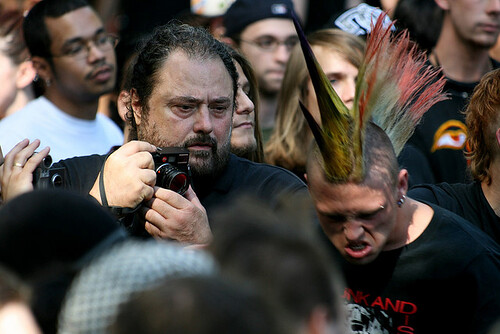 Lorcan Otway
Lorcan Otway Tonight at 7:15 p.m., friends of Bob Arihood and admirers of his work documenting the daily life of the East Village will gather at Lucy’s, with a candlelight vigil to follow at 8 p.m. at Ray’s Candy Store. Today, his body is being returned to his hometown of Lafayette, Indiana. According to Leslie Arihood, his younger brother, funeral arrangements have been tentatively set for Sunday at the Soller-Baker Funeral Home.
In the days since Mr. Arihood was found dead in his apartment, bloggers have paid tribute to him, but few personal details have emerged about the man who Wah Mohn, 21, a Columbia student and acquaintance of the photographer, called a “super loner.”
“What made Bob special was that he listened to people,” said one of the three men who found Mr. Arihood’s body on Friday, adding that Mr. Arihood was more inclined to hear someone’s life story than to tell his own.
It was just that kind of warmth that drew people to him as he canvassed the neighborhood, and last week, his conspicuous absence from his usual local haunts around Tompkins Square Park was cause for concern. So was the surgical appointment he missed on Tuesday. Read more…
 Tompkins Square Park, September 1994
Tompkins Square Park, September 1994From 1994 to 1995 I lived in a converted storefront on the Lower East Side, at 112 Suffolk Street between Delancey and Rivington Streets. Back then the neighborhood was not yet gentrified and was somewhat rough around the edges. I was a new father and even though I was pushing my baby daughter around in a stroller it took the drug dealers a couple of weeks before they realized I lived there and wasn’t there to buy heroin. I worked part-time waiting tables and working as a photographer’s assistant whenever I could; I was rarely without a camera.
I always found the temperance fountain in Tompkins Square Park to be quite out of place — not many of the park’s residents practiced temperance.
Read more…






